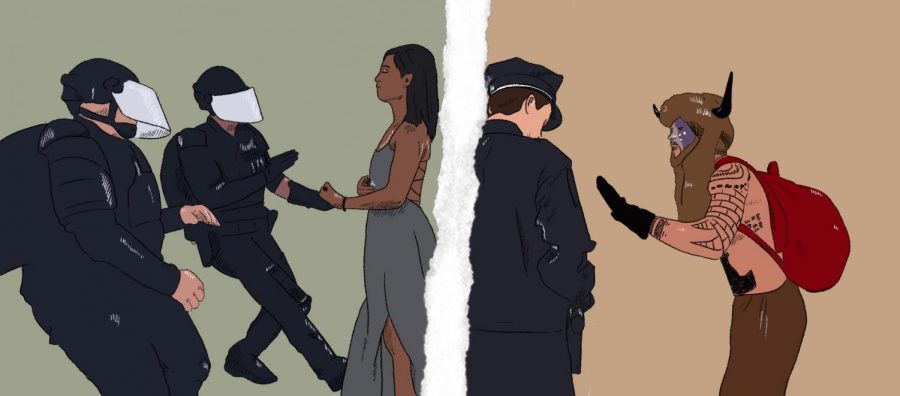History was made on Jan. 6 as Trump supporters stormed the nation’s Capitol with ease.
As America watched the news unfold that fateful morning the question in the forefront of many people’s minds was this: how would the response be different if this were a protest for Black Lives Matter?
Unfortunately, we’ve already seen what that might look like.
Footage of unmarked police officers and vehicles making arrests, police SUVs running over crowds, police officers pepper-spraying and beating unarmed protesters are just some of the examples of the police response to the Black Lives Matter protests over the past year.
On the day of the insurrection police used tear gas, flashbangs and minimal force against the rioters, some of them even carrying spears. Even videos and live-streams showed police taking selfies with the insurrectionists. While other videos showed rioters assaulting Capitol police officers, crushing them between doors and leaving one officer dead.
On Jan. 6, just 1,100 National Guard members were sent to the Capitol in the evening, hours after the pro-Trump rioters breached the building.
Almost eight months earlier, on June 2, the steps of the Lincoln Memorial were covered with national guardsmen in preparation for a Black Lives Matter protest. According to Boise State public radio, throughout the summer of 2020 approximately 4,000 national guard members were deployed to Washington D.C.
Photos and videos that circulated around social media sites were a cause for outrage among many. Comparisons were drawn between the police presence at many of the Black Lives Matter rallies over the summer and the supposed lack of it at the Capitol.
The riot on Jan. 6 was foreshadowed by Donald Trump and his supporters in December which should have provided Capitol Police and law enforcement to plan a similar response to that seen during the summer Black Lives Matter protests.
The simplest conclusion anyone can draw from analyzing the circumstances surrounding the near-coup that took place on Capitol Hill is that they should have been prepared. The government, the Trump administration – everyone should have been prepared for this.
Peacefully protesting in the streets does not compare to attacking the U.S. Capitol, just as losing an election does not compare to the countless injustices and murders of innocent Black people.
The insurrectionists justify their actions by stating the election was unfair. It is safe to say it is a part of human nature to hate to lose. The Black Lives Matter movement is powered by the search for justice. Justice for the murders of innocent black citizens at the hands of police.
The fact that the most peaceful Black Lives Matter protests were met with such a disproportionate response compared to actual domestic terrorists shows the discrimination and privilege as clear as day, in plain English, black and white.
According to Forbes, 289 arrests were made on June 1 at a Black Lives Matter rally. It is five times the number of arrests made at the Capitol on June 6.
BLM rallies were wide-spread across many major and minor U.S. cities, and the movement has made its way outside of the U.S. as well. The size and scale of the protests alone make them difficult to directly compare to the Capitol protest, but there were undoubtedly gross abuses of force at BLM rallies and a strange lack of force at the Capitol.
Perhaps it’s a step in the right direction that law enforcement acted with more restraint at the Capitol. There are a lot of reasons as to why the reaction would be different in these two instances, but the Capitol protest was certainly not peaceful.
Four deaths resulted from the attack, one protester was shot and killed by Capitol Police, and a Capitol Police Officer was killed by the violent mob according to The New York Times and ABC News.
Some are calling it a ‘failed insurrection’, others were fearful this was the beginning of a coup.
Although the Capitol protest captured the attention of millions and caused some members of Congress to fear for their lives, it did expose how far Trumpian conspirators were willing to go in the name of ‘freedom’.
The damage caused by protestors was far more dangerous to the democracy they claimed to be fighting for.
Katelynn Robinson is a sophomore studying journalism and political science. Follow her on Twitter @Katelynn11R.
Jadyn Brandt is a junior studying journalism. Follow her on Twitter @jadynbrandt.










